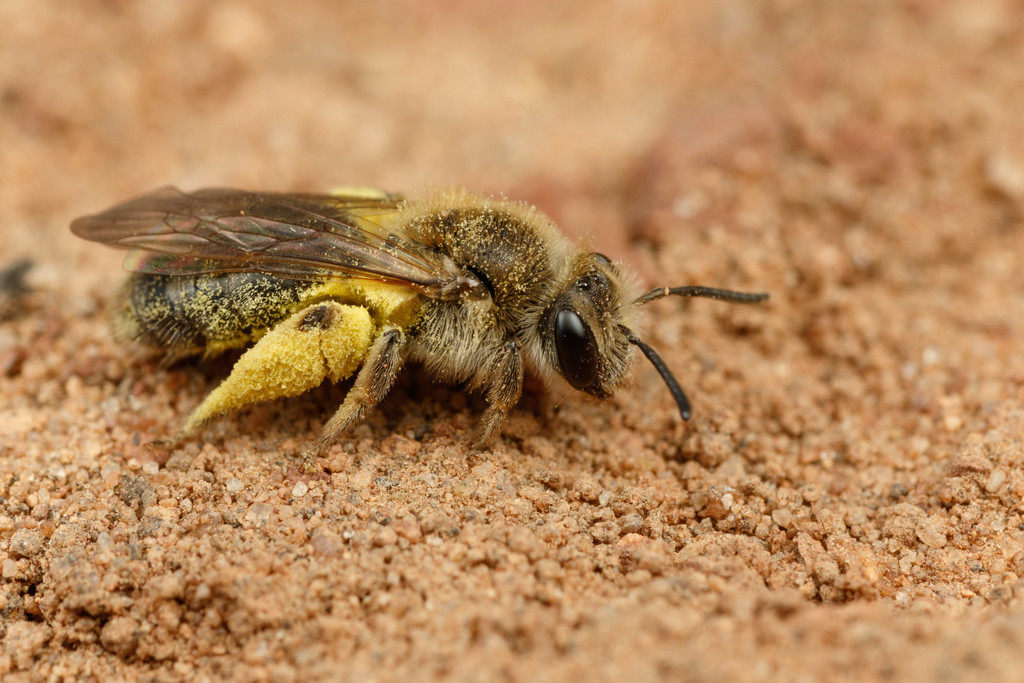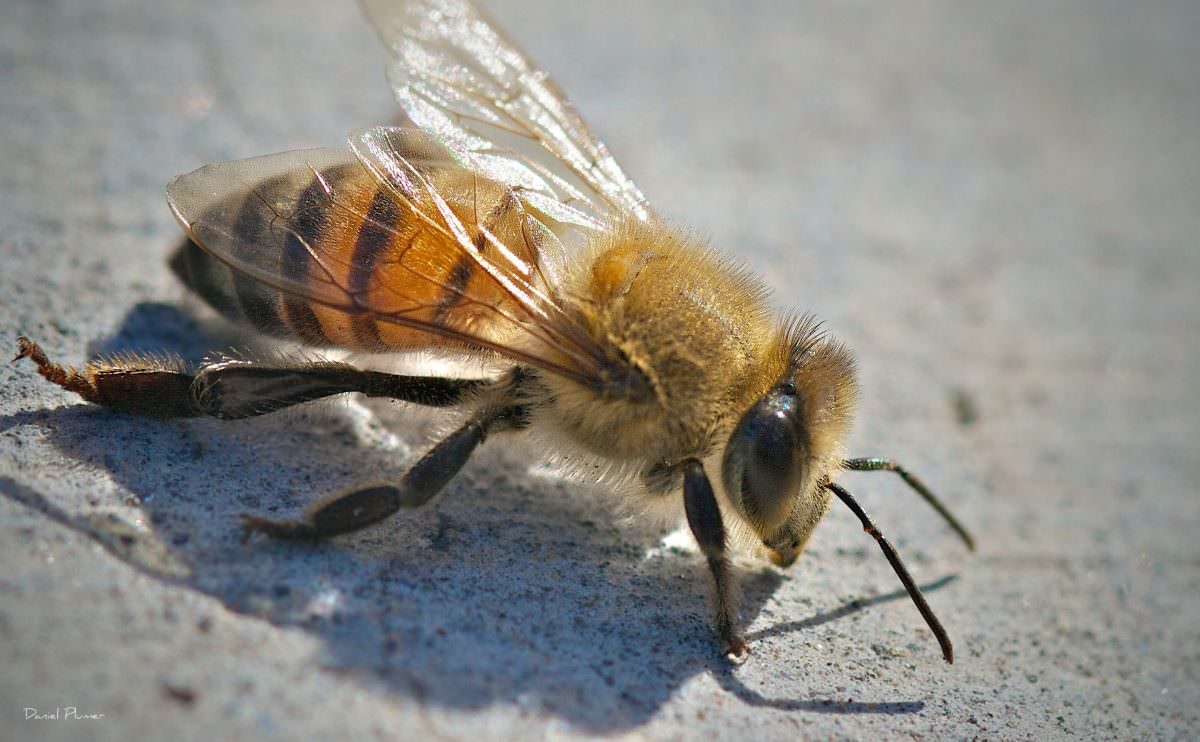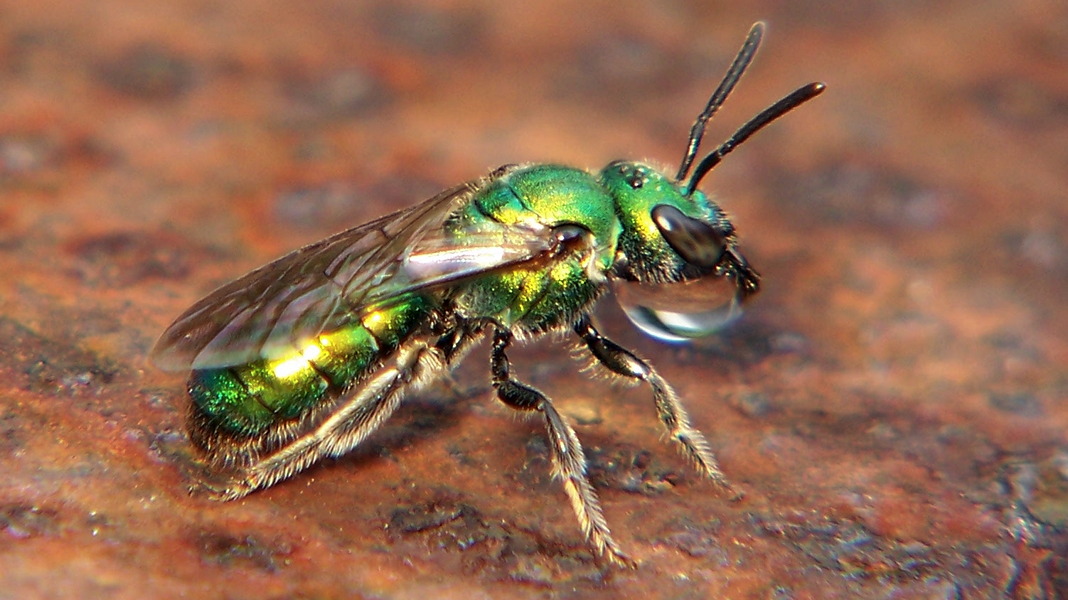Bees are fascinating creatures that play a crucial role in pollinating plants and crops. While many people associate bees with flying around flowers and plants, some types of bees prefer to create their nests in the ground.
In this article, we will explore 11 types of bees that nest in the ground, including Africanized bees, sweat bees, long-horned bees, Colletes inaequalis, Halictidae family, Andrena family, Apidae subfamily, mason bees, leafcutter bees, alkali bees, and bumblebees.
You are reading: Discover 11 Types Of Bees That Nest In The Ground
Understanding the different types of ground-nesting bees can help us appreciate their importance and coexist with them peacefully.

11 Types Of Bees That Nest In The Ground
Africanized Bee

Africanized bees, also known as Africanized honey bees or “killer bees,” are a hybrid of the western honey bee. They were produced originally by crossbreeding the East African lowland honey bee with various European honey bee subspecies such as the Italian honey bee and the Iberian honey bee.
The Africanized bee is called a “killer bee” because of its increased defensive behavior, which makes it more dangerous than regular honeybees.
Africanized bees have small colonies, so they can build nests in unique places such as tires, crates, boxes, water meter boxes, tree limbs, utility poles, junk piles, holes in the ground, mailboxes, overturned flower pots, and empty cars.
Africanized bee colonies are likely to be more common than European bees have been, and they swarm more frequently. Once disturbed, Africanized bees will continue the attack for a long distance.
Africanized bee venom is no more dangerous than regular honeybees, but these bees tend to attack in greater numbers, which causes more danger to humans.
Sweat Bee
Sweat bees are a type of ground-nesting bee that are commonly found in North America. They are usually small, measuring between 1/4 to 3/4 inch in length, and are typically black or metallic-colored.
Sweat bees are named for their attraction to human sweat, which they use as a source of moisture and salt. Most sweat bees prefer to build their nests in underground burrows within sun-exposed, bare soil, but some species will also nest in decaying wood. Sweat bees are important pollinators for crops, flowers, and trees.
some species of sweat bees are solitary, others show different levels of social behavior. Sweat bees are generally not aggressive toward humans and will only sting if they feel threatened or disturbed.
Long-horned Bee
Long-horned bees, also known as Eucerini, are a diverse tribe of bees in the family Apidae. They are named for their long antennae, which are longer than those of most other bee species. Long-horned bees are solitary, though many nest in large aggregations, and large “sleeping” aggregations of males are found occasionally.
Most genera are distinctive in the unusually long male antennae from which the tribe derives its name (eucer- means true horned). Two major genera in this group are Eucera and Melissodes.
Long-horned bees are in the same family (Apidae) as honeybees, bumblebees, carpenter bees, and others. Most long-horned bees have very particular types of plants they pollinate. For example, one species, the worthy longhorn (Florilegus condignus), specializes in pollinating the various types of pickerel weeds (Pontederia spp.), common on the shorelines of lakes and ponds.
Read more : Discover 15 Types Of Rattlesnakes In Arizona
Also in the longhorn bee tribe (group of genera) are the squash bees (Peponapis and Xenoglossa spp.), which only collect pollen from squashes, gourds, and pumpkins (Curcurbita spp.), and they are extremely important in the pollination of these plants.
Long-horned bees are active early in the day, and they are often trapped when the squash blossom wilts closed on them in the midday heat.
Long-horned bees are important pollinators for crops, flowers, and trees. Sadly, some species of long-horned bees have declined significantly across Britain and North America.
Colletes inaequalis
Colletes inaequalis is a common species of plasterer bee that is native to North America. Here are some interesting facts about this species:
– Colletes inaequalis builds cells in underground nests that are lined with a polyester secretion, earning the genus the nickname of polyester bees.
– This species is a pollinator of red maple trees, willow trees, and apple trees.
– Colletes inaequalis is perhaps the most abundant bee in Vermont from early April through May.
– Nest aggregations of Colletes inaequalis seem to appear overnight and can grow to several hundred nests.
– These bees have dark heads, dark eyes, dark thoraxes (midsections), and predominantly dark legs.
– Colletes inaequalis is an important pollinator for crops, flowers, and trees.
– A population of Colletes inaequalis was found within a local area of 14 km2, which is considered a significant range for this species.
Overall, Colletes inaequalis is an important species of ground-nesting bee that plays a crucial role in pollinating various plants and crops.
Halictidae Family

Halictidae is the second-largest family of bees, with nearly 4,500 species. They are commonly called sweat bees because they are often attracted to perspiration.
Halictid species are an extremely diverse group that can vary greatly in appearance, with some having yellow markings, especially the males, which commonly have yellow faces. The family is one of many with short tongues and is best distinguished by the arcuate (strongly curved) basal vein found on the wing. Females in this family tend to be larger than the males.
Halictidae is one of the six bee families in the order Hymenoptera. Halictids are a very diverse group of metallic and non-metallic bees, and they typically are more abundant than most bees with the exception of Apis (honey bee) species. Halictids display the most diverse gradation in social behavior, as species can be solitary, communal, semi-social, or primitively eusocial.
Most species are polylectic, or gather floral resources from multiple plant species, while there are a few oligolectic species and subgenera that feed from a single plant family. Adult halictids eat nectar and collect nectar and pollen for the larvae.
All halictids are mass provisioners, meaning that the adults provision each cell with all the food (pollen and nectar) a larva will need until it emerges.
The family Halictidae contains a few social parasites and cleptoparasitic bee genera, including Sphecodes and Microsphecodes.
Halictid bees are found worldwide, but they are especially abundant in temperate regions. In Florida, there are over 50 species of Halictidae found within the subfamilies Nomiinae and Halictinae and including the following eight genera: Sphecodes, Lasioglossum, Nomia, Agapostemon, Augochloropsis, Augochlora, Augochlorella, and Halictus.
Halictidae can be separated from other families of bees by a strongly curved basal vein found on the wing.
Andrena Family
Andrena is a genus of bees in the family Andrenidae. Here are some interesting facts about this family:
– Andrenidae is a large, nearly cosmopolitan family of solitary, ground-nesting bees. It is nearly worldwide in distribution, with the notable exceptions of Oceania and South America.
– Andrenidae is one of the six principal families of bees. It includes some enormous genera, such as Andrena with over 1,300 species, and Perdita with over 700.
– The Andrenidae are typically small to moderate-sized bees, which often have scopae on the basal segments of the leg in addition to the tibia, and are commonly oligolectic (especially within the subfamily Panurginae).
– Many Andrena are host-plant specialists, in which a species visits flowers of only a single or a few closely related plants. Oligolectic Andrena have specialized on many different plant groups and have morphological and behavioral adaptations that suit them for their pollen preference.
– Andrena is commonly known as mining bees due to their ground-nesting lifestyle. They are nearly worldwide in distribution, with the notable exceptions of Oceania and South America.
– The Andrenidae family contains 45 genera worldwide. Some of the genera in this family include Ancylandrena, Megandrena, Protoxaea, Anthemurgus, Calliopsis, Macrotera, Panurginus, and Andrena.
– Andrenidae is a strongly monophyletic group that is difficult to split into more manageable divisions; currently, Andrena is organized into 104 subgenera.
Overall, Andrenidae is a diverse family of ground-nesting bees that play an important role in pollinating various plants and crops.
Apidae Subfamily
Read more : Discover The Top 6 Rarest Tiger Species On The Planet
The Apidae family is the largest family within the superfamily Apoidea, containing at least 5700 species of bees. The family includes some of the most commonly seen bees, including bumblebees and honey bees, but also includes stingless bees (also used for honey production), carpenter bees, orchid bees, cuckoo bees, and a number of other less widely known groups.
Many are valuable pollinators in natural habitats and for agricultural crops. Here are some interesting facts about the Apidae subfamily:
– The subfamily Apinae contains honey bees, bumblebees, stingless bees, orchid bees, and digger bees, among others.
– Although the most visible members of Apidae are social, the vast majority of apid bees are solitary, including a number of cleptoparasitic species.
– The old family Apidae contained four tribes (Apinae: Apini, Euglossini and Bombinae: Bombini, Meliponini) which have been reclassified as tribes of the subfamily Apinae, along with other tribes.
– Bombus (Apidae) is a genus of approximately 265 species of mostly eusocial bumblebees that occur throughout most temperate regions of the world.
– Apidae (87 taxa) includes what Mitchell referred to as the families Anthophoridae and Apidae.
– The family Apidae is commonly known as cuckoo, carpenter, digger, bumble, and honey bees.
Overall, the Apidae subfamily is a diverse group of bees that play an important role in pollinating various plants and crops.
Mason Bee
Mason bees are a type of solitary bee that belong to the genus Osmia, which is part of the family Megachilidae. Here are some interesting facts about mason bees:
– Mason bees are named for their habit of using mud or other “masonry” products in constructing their nests, which are made in naturally occurring gaps such as between cracks in stones or other small dark cavities.
– Some species of mason bees preferentially use hollow stems or holes in wood made by wood-boring insects.
– Unlike honey bees or bumblebees, Osmia species are solitary, meaning every female is fertile and makes her own nest, and no worker bees for these species exist.
– Mason bees are cavity-nesting bees, and the females make their nests in existing cracks and crevices in walls, but they also favor hollow plant stems.
– Mason bees are important pollinators for fruit trees such as apples, plums, pears, almonds, and peaches.
– Mason bees are immune from acarine and Varroa mites, but they have their own unique parasites.
– Mason bees do not produce honey or beeswax.
– Sustainable bee habitats can be created for mason bees using high-quality materials, providing a home for the bees for many seasons.
Overall, mason bees are an important species of solitary bee that play a crucial role in pollinating various plants and crops.
Leafcutter Bee
Leafcutter bees are a type of solitary bee that belong to the Megachilidae family. Here are some interesting facts about leafcutter bees:
– Leafcutter bees are important native pollinators of North America. They are important pollinators of wildflowers, fruits, vegetables, and other crops.
– Leafcutter bees use cut leaves to construct nests in cavities, mostly in rotting wood. They construct cigar-like nests that contain several cells, each with a single larva and pollen for the larva to eat.
– Leafcutter bees are solitary species belonging to the Megachile genus of bees. They are fascinating to watch and provide a unique addition to any garden.
– Leafcutter bees are only active in your garden for about 4-6 weeks, beginning in summer. They spend the rest of their lives inside their nesting chambers, eating, growing, spinning cocoons, overwintering as mature larvae, and finally developing into adults when summer temperatures reach a consistent 70°F/21°C.
– Leafcutter bees are cavity-nesting insects and nest in hollow stems of plants or tunnels or holes formed by wood-boring insects in the wild. This nesting behavior allows us to provide artificial nests constructed of wood trays, bundles of cardboard straws, or natural reeds to help leafcutter bee populations thrive in our backyards and gardens.
– Leafcutter bees need soft, flexible leaves to construct their nests and will use the leaves of almost any broadleaf deciduous plant.
Overall, leafcutter bees are an important species of solitary bee that play a crucial role in pollinating various plants and crops.
Alkali Bee
The alkali bee (Nomia melanderi) is a ground-nesting bee native to deserts and semi-arid desert basins of the western United States. Here are some interesting facts about this species:
Physical Characteristics:
– The alkali bee is about two-thirds the size of a honeybee with black and metallic banding on the abdomen.
– Females have, but infrequently use, stingers and the males have white faces.
– Males and females in the northern part of the range are larger than their counterparts to the south.
Behavior:
– While solitary, these bees nest near each other and can form large aggregations.
– These bees are important pollinators of alfalfa, which is used as feed for livestock.
– Alkali bees are members of the Halictidae family, which includes a diverse array of other solitary ground-nesting species.
– These bees are known as alkali bees because they prefer to nest in soil with a salty crust which covers a damp, saline soil beneath.
– Alkali bees are workhorses when it comes to pollinating and are highly in demand by farmers who grow alfalfa.
Overall, the alkali bee is an important species of ground-nesting bee that plays a crucial role in pollinating alfalfa crops.
Bumble Bee
Bumblebees are a type of bee that belong to the genus Bombus, which is part of the family Apidae. Here are some interesting facts about bumblebees:
Physical Characteristics:
– Bumblebees are large, fuzzy insects with short, stubby wings.
– They are typically black with yellow stripes, although some species have orange or red markings.
– Bumblebees are the only bees that have the ability to thermoregulate their body temperature.
Behavior:
– Bumblebees are important pollinators of wild flowering plants and crops. As generalist foragers, they do not depend on any one flower type.
– Bumblebees are the only bees native to North America that are truly social. They live in colonies, have different divisions of labor or castes, and have overlapping generations, usually with multiple broods throughout the spring, summer, and fall.
– Unlike honeybees, bumblebee colonies have an annual life cycle. At the end of the summer, the foundress queen, her workers, and male offspring will all die.
– Bumblebees are important pollinators of crops such as tomatoes, peppers, and blueberries.
– Bumblebees are declining in numbers due to habitat loss, pesticide use, and climate change.
– There are over 250 species of bumblebees in the genus Bombus. In the UK, there are 24 species of bumblebees.
Overall, bumblebees are an important species of bee that play a crucial role in pollinating various plants and crops.
FAQS
1. What are ground-nesting bees?
Ground-nesting bees are a type of bee that prefers to create their nests in the ground. They are important pollinators for various plants and crops.
2. What are some types of ground-nesting bees?
Some types of ground-nesting bees include Africanized bees, sweat bees, long-horned bees, Colletes inaequalis, Halictidae family, Andrena family, Apidae subfamily, mason bees, leafcutter bees, alkali bees, and bumblebees.
3. Why do bees nest in the ground?
Bees nest in the ground because it provides a safe and secure location for their offspring. Ground-nesting bees are able to create their nests in a variety of locations, including soil, sand, and even rotting wood.
4. Are ground-nesting bees dangerous?
Most ground-nesting bees are not dangerous and will only sting if they feel threatened or disturbed. However, Africanized bees can be more aggressive and dangerous than other types of bees.
5. How can I attract ground-nesting bees to my garden?
You can attract ground-nesting bees to your garden by providing them with a suitable habitat, such as a patch of bare, well-drained soil. You can also plant flowers and other plants that are attractive to bees.
6. How can I identify different types of ground-nesting bees?
You can identify different types of ground-nesting bees by their appearance, nesting habits, and behavior. Using a ground-nesting bees identification chart can also be helpful.
Source: https://petstutorial.com
Category: Animals










